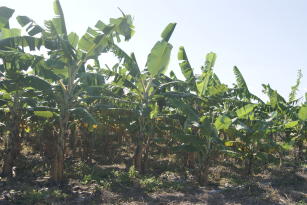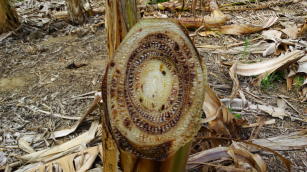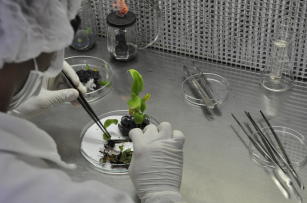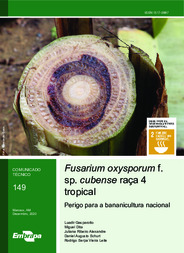 Busca de Notícias
Busca de Notícias
Brazil prepares actions to prevent entry of new race of fusarium wilt of bananas
Photo: Fernando Goss

Plant affected by Fusarium wilt, considered the greatest threat to banana cultivation in the world.
Tropical race 4 (TR4) of the Fusarium wilt of banana fungus has recently been detected in Colombia. That is the only race of the Fusarium oxysporum f. sp. Cubense microorganism that is absent in Brazil, and for which there are still no resistant cultivars. It is the causative agent of the disease known as Fusarium wilt or fusariosis (formerly known as Panama disease), considered to be the main pathology attacking banana groves.
To anticipate the problem, researchers from Embrapa Western Amazon (Manaus, AM), Embrapa Roraima (Boa Vista, RR) and Bioversity International, situated in Cali, Colombia, in partnership with the Federal Superintendency of Agriculture in Amazonas (SFA/AM, from Portuguese), have produced a technical notice addressed to farmers and extension workers, intending to warn and guide them on how to protect themselves against the quarantined race.
Fusarium wilt is one of the banana plant’s most destructive diseases and is the one that causes the most damage to the crop. The phytopathogen inhabits the soil and can survive without the host for many decades.
TR4 has spread to Australia, China, the Philippines, Indonesia, Laos, Lebanon, Malaysia, Mozambique, Myanmar, Oman, Pakistan, Taiwan and Vietnam and has been recently found in Colombia, putting Brazilian banana cultivation at risk.
The technical document presents the symptoms caused by the disease, comparing them to the signs of Moko (Ralstonia solanacearum, race 2) and abiotic wilting through several photographs, to make it easier to monitor and detect TR4 in Brazilian banana groves in the field. The publication also addresses what cautions must be taken during the evaluation and when an occurrence is suspected.
According to Embrapa researcher Luadir Gasparotto, a possible occurrence of TR4 can be indicated by observing cultivars that are resistant to races 1 and 2, which are called "sentinels", such as those of the Cavendish subgroup (Dwarf, Nanicão, Grand Nain, etc.), Plantain subgroup (D'Angola, known in Amazonas as Pacovan, Comprida, Farta Velhaco, Terra Anã, etc.), Thap Maeo, Caipira, BRS Conquista, Pacovan Ken, BRS Japira, BRS Vitória , BRS Caprichosa and BRS Princesa.
After analyzing the cultivars of bananas that are resistant to pathogen races 1 and 2 – and the conclusion is that the disease is caused by TR4 – the technician, or farmer, must not collect samples or perform any activity on that crop. They must isolate the area and prevent people from entering.
The diseaseThe banana plant (Musa spp.) is affected by several diseases, one of which is Fusarium wilt, identified for the first time in 1876, in Australia.
Symptoms caused by TR4 are similar to those caused by races 1 and 2. That is why it is important to access the technical document observing the characteristics contained in the photographed images. Photo: Miguel Dita |
In Brazil, the correct procedure is to contact, as soon as possible, the state Federal Superintendency of Agriculture, which will collect samples, send them to a laboratory that is officially accredited by the Ministry of Agriculture to identify the agent, and adopt mitigation measures to avoid the dissemination of the pathogen to other crops.
Given that there are no cultivars that are resistant to tropical race 4, farmers must observe the prohibition of importing banana and heliconia seedlings from countries where the pest occurs, especially Colombia.
Since the causative agents of fusarium wilt can remain in the soil for more than 30 years, banana producers should only use seedlings of safe and proven origin, preferably produced in vitro, in order to minimize the risks of introducing pests into the production area.
If during the crop treatments farmers observe symptoms that indicate the presence of the pests described in the document, they must not use the same management tools (machete, desuckering tool, digging tool, etc.) on other plants before disinfecting them with sodium hypochlorite.
Research work
Embrapa Roraima has been working in partnership with Embrapa Western Amazon to develop research aimed at the biological control of fusariosis, in order to identify bacterial and fungal isolates to control the disease. Work is also being carried out in conjunction with other Embrapa Units for breeding and genetic improvement of the banana plant, with more resistant materials and with good acceptance in the consumer market.
In the Laboratory of Phytopathology of Embrapa Roraima research is being carried out to find efficient microorganisms of economic interest for the control of Fusarium oxysporum f.sp. Cubense (FOC). The work focuses on Fusarium race 1, present in Brazil, which attacks bananas of the Apple group. As for tropical race 4 (TR4), no work is being conducted, due to it being a quarantined pest that is absent in Brazil. That is why its introduction in the country is prohibited.
The research carried out in the laboratory -- according to Embrapa Roraima researcher Daniel Schurt, responsible for conducting the work -- aims to find microorganisms in healthy bananas grown in the state and in already adapted conditions. To that end, roots of banana varieties are taken from Embrapa's collection and from different producers. "Bacteria and gungi are isolated from such roots, and these isolates are subsequently purified and assessed in a controlled laboratory environment to test their effectiveness in fighting the causative agent of FOC. After testing, seedlings with the inoculated biological control agent go to the field," he explains. If the results are positive, in the future, farmers will be able to buy seedlings that have already been inoculated with the disease's biological control agent.
Mapa's missions
As a preventive measure, Embrapa's phytopathologists have been helping Mapa (Brazilian Ministry of Agriculture, Livestock, and Food Supply) and the Agricultural and Livestock Defense Agencies of Roraima (ADERR) and of Amazonas make annual visits to the state's municipalities to monitor sentinel banana plants, in order to verify whether or not the disease is present in these plants, monitoring the presence of FOC in Roraima.
During those visits, guidelines are given to the main banana farmers so that, should any abnormality occur, the necessary measures can be taken as soon as possible. If any plant suspected of the disease is identified, the samples are immediately sent to one of the units of Mapa's National Agricultural Laboratory (Lanagro) network, which is responsible for the samples' official diagnosis.

Photo: iStock/ Gerson Fortes
AuthorsThe Technical Notice is signed by researchers Luadir Gasparotto (Embrapa Western Amazon), Daniel Augusto Schurt (Embrapa Roraima), Miguel Dita (Bioversity International, Cali, Colombia) and Rodrigo Serpa Vieira Leite (SFA-AM/Ministry of Agriculture, Livestock, and Food Supply, Manaus, AM). |
Training
In addition to the courses and monitoring conducted with the farmers, phytopathologists from Embrapa Roraima, Embrapa Western Amazon and Embrapa Acre also carry out technical training for federal and state inspectors, with periodic visits to places where banana Fusarium race 1 is present in their states.
They are also participating in events with farmers and extension workers giving lectures on the topic, to explain how the infection happens and what to do when the problem, which may be related to Fusarium wilt race 4, is detected.
Due to the Covid-19 pandemic, training had to be adapted to the digital format, enabling distance training of Roraima state inspectors.
For Schurt, awareness is one of the main allies in reducing the incidence of the disease. "We always try to inform producers and defense agents about the importance of taking care of banana groves, buying certified seedlings and not bringing biological material from other countries, especially from regions where the pest is present. That greatly reduces the risk of contamination and helps prevent the disease," he points out.
Maria José Tupinambá (MTb 114/AM)
Embrapa Western Amazon
Press inquiries
amazonia-ocidental.imprensa@embrapa.br
Phone number: +55 92 3303-7800
Collaboration: Aliny de Melo
Embrapa Roraima
Translation: Raquel Porlan, supervised by Mariana Medeiros (13044/DF)
General Secretariat
Further information on the topic
Citizen Attention Service (SAC)
www.embrapa.br/contact-us/sac/

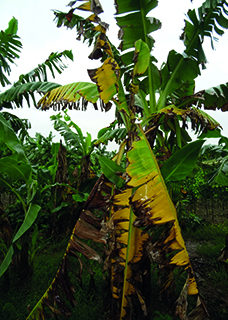 The races that affect the plant are divided into 1, 2, and 4, which is subdivided into subtropical ST4 and TR4. Race 1 affects the Gros Michel, Apple and Pome cultivars, etc; race 2, the group Figo or Bluggoe ones; and TR4, the ones of the Cavendish
The races that affect the plant are divided into 1, 2, and 4, which is subdivided into subtropical ST4 and TR4. Race 1 affects the Gros Michel, Apple and Pome cultivars, etc; race 2, the group Figo or Bluggoe ones; and TR4, the ones of the Cavendish 